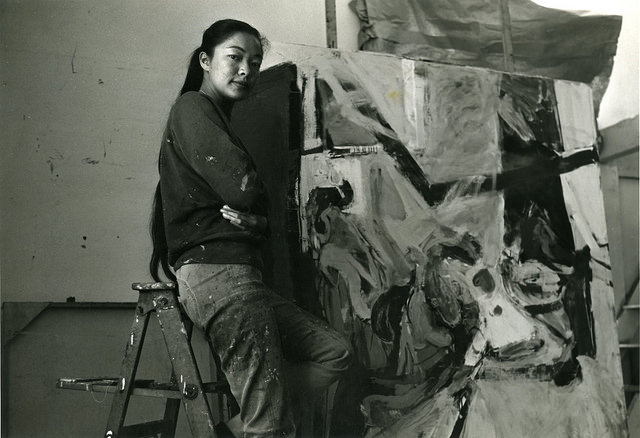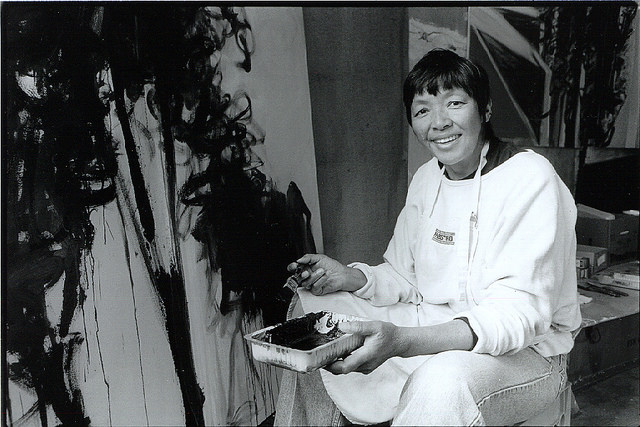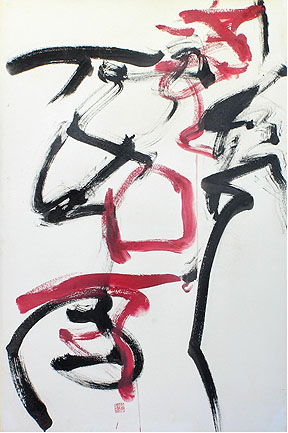
“Once upon a time it was rare to find any Asians in prestigious art schools.”
This is the first sentence of groundbreaking artist Bernice Bing’s statement for the 1990 six-woman exhibit “Completing the Circle” featuring notable Chinese American female artists, and which showed at the Southern Exposure Gallery, San Francisco. That this is how Bing chose to begin her statement is telling; Bernice Bing was one of the nation’s earliest Asian American artists to break into the elite world of modern art.
 Bernice Bing was born in 1936, in San Francisco’s Chinatown (check out this fascinating chronology on Bing’s life based on a series of interviews with her). Before the age of six, Bing’s mother passed away and Bing and her sister were placed in White foster homes where Bing struggled to navigate between her predominantly White world and Asian American self. In college, Bing pursued her growing affinity for art, and quickly became influenced by her instructors, including two Japanese artists and calligraphers, to develop a unique “calligraphy-inspired abstraction” signatory style to her paintings.
Bernice Bing was born in 1936, in San Francisco’s Chinatown (check out this fascinating chronology on Bing’s life based on a series of interviews with her). Before the age of six, Bing’s mother passed away and Bing and her sister were placed in White foster homes where Bing struggled to navigate between her predominantly White world and Asian American self. In college, Bing pursued her growing affinity for art, and quickly became influenced by her instructors, including two Japanese artists and calligraphers, to develop a unique “calligraphy-inspired abstraction” signatory style to her paintings.
Bing, known by most as “Bingo”, came of age artistically during the Beat Generation, and became well-known in San Francisco and throughout the art world for her powerful use of line and colour to explore a variety of subjects, all centered around the understanding of self (a theme reinforced by Bing’s embrace of Zen Buddhism in her later years).
From a 1996 essay on Bing written by Flo Oy Wong:
At Mayacamas Vineyards, drawn to the magnificence of nature, Bing voraciously studied the work of C. G. Jung, embracing his concept of the spiritual aspects of visual work. She subsequently painted a Mayacamas series for which she received another Artforum review in 1964. As an artist in the first residential program at Esalen (1967-68), a center for parapsychology and religious philosophy, Bing absorbed herself in exploration levels of the unconscious mind. She reached for the essence of self through the deconstruction of superficialities. Psychological dialogues entered into her artistic consciousness, motivating Bing to paint a work entitled Big Sur , which symbolized breaking through to the core of her inner self.
These experiences at Esalen took Bing further away from her traditional Chinese environment, where family and cultural dynamics discouraged explorations of self, toward Western culture’s emphasis on the individual. Bing transformed this cultural intersection in her paintings to create synergistic threads of fluidity/rigidity and dark/light.

Bing was extremely dedicated to community work, and in the 1970’s, when San Francisco’s Chinatown area was in political upheaval and turmoil, Bing established the city’s first Asian American art festival.
Later in life, Bing served on the National Endowment for the Arts Expansion Program panel in Washington DC, and worked with several local community programs to bring art into the community. In 1980, Bing was appointed the Director of the South Of Market Cultural Center (SOMAR), one of four cultural centers run by the San Francisco Arts Commission at the time. After significantly expanding the program, Bing left to focus on her art in Philo, California.
In 1989, Bing joined the newly formed Asian American Woman Artists Association (AAWAA), a phenomenal non-profit that remains highly active today, and whose mission is to promote the voices of Asian American women through art. Bing remained a visionary artist and community activist until her death in 1989.
On Sunday, September 28, 2-4pm at the Asian Art Museum at Samsung Hall (200 Larkin Street), AAWAA joins forces with the Asian Art Museum, Asia Society, and Center for Asian American Media to host “Divided Attention“, a three-part event featuring a showing of “The Worlds of Bernice Bing” , a short documentary film that will highlight Bernice Bing’s many contributions to the arts and the community, along with an audience Q&A and a star-studded panel discussion. The showing is part of a week-long series of events included in next week’s Asian Contemporary Art Week.
From their press statement:
Asian American Women Artists Association (AAWAA), Asian Art Museum, Asia Society, and Center for Asian American Media (CAAM) presents THE WORLDS OF BERNICE BING, a documentary short film illuminating the life and times of visionary artist, Bernice Bing, also known as Bingo—fine artist, community activist, lesbian, and Asian American. Through archival footage and interviews with scholars, colleagues, and friends, the film documents the importance of Bing’s place in American art history. From her art studio in North Beach, to her groundbreaking community work to her later life in rural northern California, Bing chose not to follow the trends of the day and created art on her own terms. The film tells the powerful and inspirational story of a unique American icon of the arts, finally giving Bingo the attention she so well deserves.
A very special audience Q&A and panel discussion will follow the film, and will include a veritable who’s who of the many communities Bing became involved in. In addition to “The Worlds of Bernice Bing” director Madeleine Lim, the panel will include film collaborators Jennifer Yoshida Banta, Lenore Chinn and Nancy Hom; also on the panel are Kim Anno (artist and California College of Arts professor of Fine Arts), Thao Nguyen (writer, performer and doctoral student at Stanford University), and Malik Seneferu (arist). The panel will be moderated by Tina Takemoto (artist, associate professor of Visual Studies at California College of the Arts, and board member of the Queer Cultural Center). The panel will focus on how artists navigate the intersection of their multiple identities, and often told to compartmentalize who they are in order to remain relevant in contemporary art.
If you are in the San Francisco area next weekend, you should definitely check out this film and panel. Tickets are just $15 (and include museum admission).
To whet your appetite, please check out the Queer Cultural Center’s phenomenal digital exhibit on Bernice Bing, her life and her work, including several incredible reproductions of her exhibits and individual paintings. This documentary-associated Flickr also has some great images.
Correction: An earlier version of this post mistakenly identified the title of the documentary as “Divided Attentions: The Worlds of Bernice Bing”. The name of the event is “Divided Attentions” and the name of the film is “The Worlds of Bernice Bing”. My apologies for the error.

